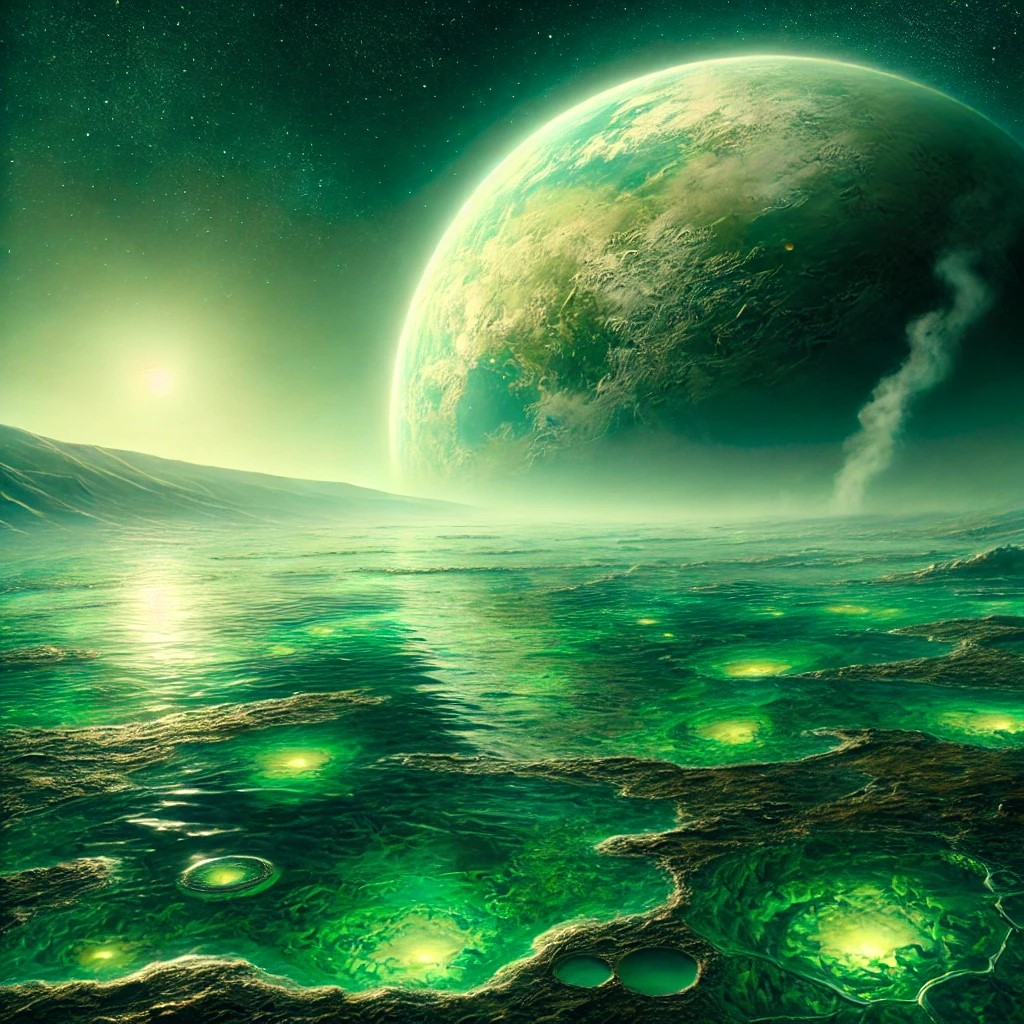New Research Indicates Earth's Earliest Oceans Were Green, Not Blue
Using advanced simulations, researchers discovered that the underwater light spectrum during the Archaean era (4–2.5 billion years ago) appeared green due to iron precipitation. At that time, Earth's oceans were rich in ferrous iron, released by hydrothermal vent systems. The Great Oxidation Event later altered this balance, as oxygen reacted with the iron, converting it from ferrous to ferric iron.

Figure 1. Earth’s Ancient Oceans: A Green World, Not Blue.
Ferric iron has distinct properties, including being insoluble, which caused it to precipitate as rust-like particles. These iron-rich particles altered the wavelengths of light penetrating the water. By preferentially absorbing blue and red light, they allowed mainly green light to pass through, giving the underwater environment a green hue. Figure 1 shows Earth’s Ancient Oceans: A Green World, Not Blue.
"Genetic analysis revealed that cyanobacteria possessed a specialized phycobilin protein called phycoerythrin, which efficiently absorbed green light," Matsuo explained. "We believe this adaptation enabled them to flourish in the iron-rich, green oceans."
Could We Be Searching for the Wrong Signs of Alien Life?
Matsuo believes his research could aid the search for extraterrestrial life. On modern Earth, oceans appear blue because water absorbs red light and scatters blue. However, during the Archaean era, iron precipitation may have caused the oceans to efficiently reflect green light. This suggests that detecting green oceans on distant planets could serve as a potential indicator of primitive life.
Matsuo is particularly excited about how green oceans might enhance the search for alien life. “Remote-sensing data show that waters rich in iron hydroxide, such as those around Iwo Island in the Satsunan archipelago, appear noticeably brighter than typical blue oceans,” he explained. “This suggests that green oceans could be visible from greater distances, making them easier to detect.”
The Green Ocean Hypothesis
This research highlights the intricate relationship between Earth's surface environment and photosynthetic organisms. The findings suggest that the emergence of photosynthetic life triggered environmental changes, which in turn fueled the further evolution of these organisms—demonstrating how life and the planet have coevolved over time.
Matsuo believes the green ocean hypothesis unites key discoveries about Earth's early history. “When I first considered the idea that the oceans were once green, back in 2021, I was more skeptical than anything else,” he admitted. “But now, after years of research, as geological and biological insights have come together like pieces of a puzzle, my skepticism has turned into conviction.”
“For me personally, a major turning point was our field survey on Iwo Island in the Satsunan archipelago in 2023,” Matsuo added. “From the boat, we could see the surrounding waters had a distinct green shimmer due to iron hydroxides—exactly how I imagined the Earth used to look.”
The Archaean Era – A Different Oceanic World
Earth’s early oceans, during the Archaean era (4–2.5 billion years ago), were not the familiar blue we see today. Instead, they had a green hue due to high levels of dissolved ferrous iron, released by hydrothermal vents. Unlike modern oceans, which reflect blue light, these iron-rich waters altered the underwater light spectrum, leading to a strikingly different marine environment.
The Role of Iron and Light Absorption
Ferric iron, formed through oxidation, is insoluble and precipitates as rust-like particles. These iron particles absorbed blue and red wavelengths while allowing green light to pass through, giving the water its greenish appearance. This shift in light absorption had a profound impact on early marine ecosystems, influencing the evolution of photosynthetic life.
Cyanobacteria’s Adaptation to Green Oceans
Early cyanobacteria, key players in Earth’s oxygenation, adapted to these green waters by evolving specialized pigments. One such pigment, phycoerythrin, allowed cyanobacteria to efficiently absorb green light, optimizing their photosynthesis. This adaptation contributed to their survival and eventual role in triggering the Great Oxidation Event (GOE), which transformed Earth’s atmosphere and oceans.
Implications for the Search for Alien Life
The discovery of Earth’s ancient green oceans suggests that similar conditions could exist on other planets. If iron-rich waters reflect green light, astronomers could use this as a potential biosignature when analyzing exoplanets. By studying planetary atmospheres and oceanic colors, researchers may improve their ability to detect primitive extraterrestrial life.
Source: SciTECHDaily
Cite this article:
Priyadharshini S (2025),”New Research Indicates Earth's Earliest Oceans Were Green, Not Blue", AnaTechmaz, pp.1115

